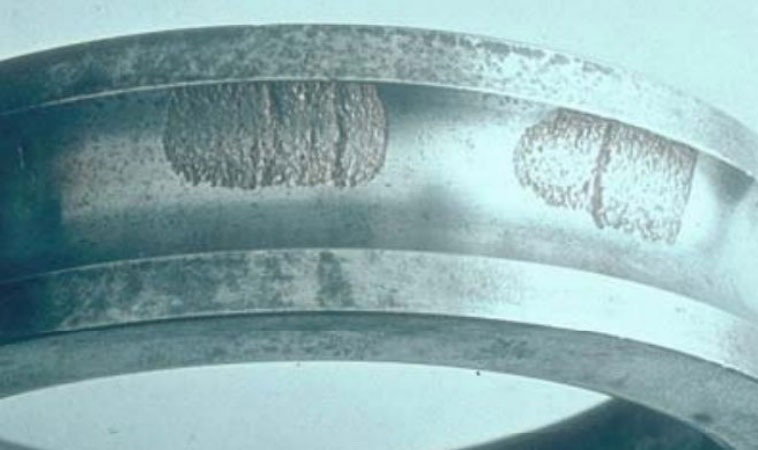In today's industrial maintenance, the use of a number of installed equipment, aligning and diagnosing equipment failures has created a breakthrough in the maintenance of the Conditional Maintenance model. However, in reality, the failures still happen and the problem is to find out the cause that leads to the failure of the bearing.
In addition to using advanced diagnostic equipment to find out the cause of failure, it is also very important to diagnose faults through physical inspection based on failure signs.

Just based on the remaining traces on the damaged bearing, we can partly identify the cause of this failure of the bearing. If a bearing fails, try to find the cause and prevent it from repeating. Bearing failure can be caused by the following:
- Installed incorrectly
- Lack of lubricant
- There are impurities mixed in the Bearing
- There is water in the Bearing
- The Support Shaft or Housing is not smooth
- Due to vibration
- Electric current movement
- Natural wear and tear
In addition to failures caused by operating conditions, improper installation accounts for 16% of the reasons that lead to bearing failure.
Below are some typical types of damage to Bearings and Housings
1. DENT
Usually dents appear when the bearing is incorrectly installed or due to overload
| Traces left | The cause of the failure | Remedies |
| Indents appear on both the inner and outer rings of the bearing and are spaced evenly by the distance between the rollers (or the ball) | Force exerted too much when mounting | When installing, use a reasonable installation tool such as: The ball-closing device, the heating device ... In the absence of these tools, when installed, the force should be applied evenly on both rings of the bearing. |
| Tapered ball bearing is too tight | When installing taper hole bearings, it is advisable to follow specific instructions on installing tapered bearings. | |
| Bear static load due to vibration when inactive | Prevent sources of vibration from impacting on the device when it is not operating | |
 |
 |
 |
2. METAL SURFACE HAIR:
Metal surface peeling phenomenon is often caused by the following reasons: Due to the large initial load, distorted bearings, oval, too great axial pressure, due to misalignment of the bearings.
a. Metal surface peeling due to too great initial load
If too much force is applied to the bearing mounted on the silver or the cone shaft, the bearing will overload and cause surface pitting.
| Traces left | The cause of the failure | Remedies |
| The roller mark is marked on the rollers of the inner ring and outer ring | Initial load is too large due to too tight fitting | Check the mounting tolerances again or use bearings with larger allowances |
| Flakiness usually occurs in the bearing areas | Tapered ball bearing is too tight | When installing taper hole bearings, it is advisable to follow specific instructions on installing tapered bearings |
| Tapered or ball bearing bearings are pre-stressed too large | Adjust the axial clearance and post-tensioning as required | |
 |
 |
 |
b. Metal surface peeling due to deformed bearing, oval::
| Traces left | The cause of the failure | Remedies |
| Bold rolling marks appear on the inner or outer ring of the bearing at symmetrical positions | The shaft or bearing is oval | Check the oval of the shaft or bearing again. This error is common for two-half bearings. |
| The bearing is placed on an uneven surface, thus during the tightening process | It is necessary to check the flatness of the plane in contact with the bearing base. | |
| Tightening the bearing base bolts will make the bearing oval | Can use the gauges to check | |
 |
 |
|
c. Metal surface peeling due to excessive axial pressure
The axial overload is usually caused by the bearing being stuck. When the shaft is thermally expanded, it narrows the gap in the bearing and causes destruction.
| Traces left | The cause of the failure | Remedies |
|
Ball bearing: The roller is bold and skewed toward both sides of the ball bearing. These flaking positions are symmetrical (in the direction of the load line). For self-selected two-row bearings, ball bearings and drum balls. The imprint is on a series of marbles with the surface pitting. For ball block bearings, the remaining sign is the same as when the initial load is too large |
Due to incorrect mounting method, large axial force and large initial load are generated The axial clearance is not large enough for thermal expansion |
Installed according to the correct method, assembly tolerance |
 |
 |
 |
d. Metal surface peeling due to misaligned bearings
| Traces left | The cause of the failure | Remedies |
|
For cylindrical roller bearings, one side of the roller will peel off. For ball bearings, the peel is bold, symmetrical, and not parallel to the roller groove |
The mounting bearing is not perpendicular to the shaft The shaft is angled The bearing is slanted in the hole |
Check the shaft angle deviation |
 |
 |
 |
3. CRACKING
| Dấu vết còn sót lại | The cause of the failure | Remedies |
| Cracks or debris usually appear on one side of the inner or outer ring | Due to strong hammering directly to the bearing during assembly | Due to strong hammering directly to the bearing during assembly |
| Due to strong hammering directly to the bearing during assembly | Due to the mounting of the taper hole bearings too tension | Install according to the instructions for installing the tapered ball bearing. Check mounting tolerances |
 |
 |
 |
4. LUBRICATION
nsufficient lubrication or ineffective lubrication also causes bearing failure. A bearing that does not have enough lubricant will have a glossy surface and it will fail in a very short time.
Another form is poor lubrication, which is caused by too much lubricant
|
Insufficient lubrication |
 |
Too much lubricant causes the rollers to slip |
5. VIOLENCE
Device vibration is one of the main causes of bearing failure. Aligning the device when assembling and analyzing the cause of device vibration is essential and important work to be done to limit failure.
|
|
 |
|





















